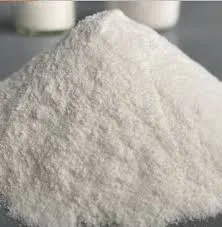
Dez . 24, 2024 09:02 Back to list
Solubility of Hydroxyethyl Cellulose in Various Alcohols and Its Implications
Understanding Hydroxyethyl Cellulose Solubility in Ethanol
Hydroxyethyl cellulose (HEC) is a non-ionic, water-soluble derivative of cellulose, widely utilized in various industrial and consumer applications. Its unique properties make it a valuable ingredient in personal care products, pharmaceuticals, food items, and construction materials. One of the significant factors that determine its utility is its solubility in different solvents, particularly ethanol.
Chemical Structure and Properties of Hydroxyethyl Cellulose
HEC is synthesized by the etherification of cellulose using ethylene oxide, introducing hydroxyethyl groups into the cellulose backbone. This modification enhances the hydrophilicity of the cellulose molecule while retaining its essential characteristics. As a result, HEC exhibits excellent film-forming, thickening, and stabilizing properties. It is capable of dissolving in water, forming a clear viscous solution that is advantageous in many formulations.
The solubility of HEC in various solvents, including ethanol, is influenced by its molecular weight, degree of substitution (DS), and the presence of other formulation ingredients. Generally, lower molecular weight HEC tends to dissolve more easily compared to high molecular weight variants, as the chain entanglement is less pronounced.
Ethanol as a Solvent
Ethanol, also known as ethyl alcohol, is a widely used solvent in the chemical, pharmaceutical, and food industries due to its effectiveness, low toxicity, and capability to dissolve a broad range of compounds. Ethanol is commonly used in formulations for pharmaceuticals and personal care products to enhance the delivery of active ingredients and improve the overall aesthetic properties.
When considering the solubility of HEC in ethanol, it is crucial to note that HEC is not readily soluble in pure ethanol. This characteristic can be attributed to the non-polar nature of ethanol, which limits its ability to interact effectively with the polar hydroxyethyl groups of HEC. However, HEC can be partially soluble in ethanol when mixed with certain additives or co-solvents, leading to increased solubilization.
Factors Affecting HEC Solubility in Ethanol
Several factors can influence the solubility of HEC in ethanol, including
hydroxyethyl cellulose solubility in ethanol

2. Temperature Temperature plays a significant role in solubility. Typically, increasing the temperature can enhance the solubility of HEC in ethanol by providing sufficient energy to overcome the intermolecular forces.
3. Presence of Other Solvents The addition of co-solvents such as water, glycerol, or propylene glycol can significantly improve the solubility of HEC in ethanol. These solvents can create a more favorable environment for HEC dissolution by disrupting the hydrogen bonding network, thus facilitating better interaction between HEC and ethanol.
4. Degree of Substitution (DS) The degree of substitution of HEC affects its solubility. Higher DS often leads to increased hydrophilicity, which may enhance solubility in mixed solvent systems.
Applications of HEC in Ethanol-based Formulations
Despite its limited solubility in pure ethanol, HEC remains a valuable additive in various formulations. In pharmaceuticals, HEC is often incorporated into gels and creams where alcohol is used as a solvent, enhancing the texture and stability of the final product. In food applications, HEC functions as a thickener and stabilizer in formulations that may contain ethanol, contributing to improved mouthfeel and consistency.
Furthermore, in the construction industry, HEC can be used in cement and mortar applications containing ethanol. Its thickening and water-retention properties help to improve the workability of mixtures, making it easier to handle and apply.
Conclusion
In summary, the solubility of hydroxyethyl cellulose in ethanol is a multifaceted topic that is influenced by various factors such as molecular weight, temperature, and the presence of co-solvents. While HEC is not readily soluble in pure ethanol, its performance can be enhanced in mixed solvent systems, making it a versatile additive in numerous formulations. Understanding the solubility characteristics of HEC in ethanol is critical for maximizing its effectiveness in diverse applications across multiple industries.
-
tile-bonding-additives-for-stronger-bonds
NewsAug.22,2025
-
construction-grade-rdp-for-wholesale-needs
NewsAug.22,2025
-
trusted-wholesale-hec-partners
NewsAug.22,2025
-
hec-solutions-for-industrial-excellence
NewsAug.22,2025
-
construction-additives-need-hpmc-essentials
NewsAug.22,2025
-
hpmc-versatile-cellulose-ether-for-industries
NewsAug.22,2025







